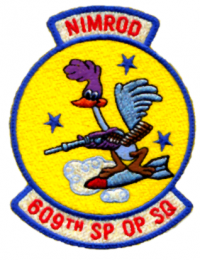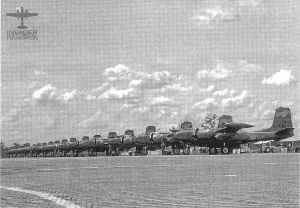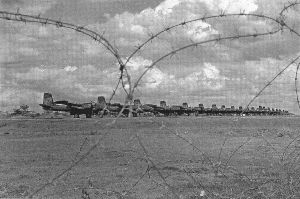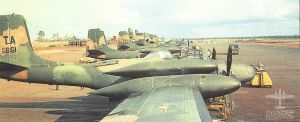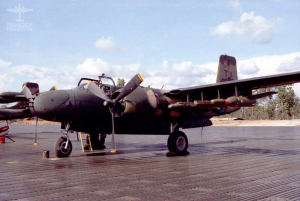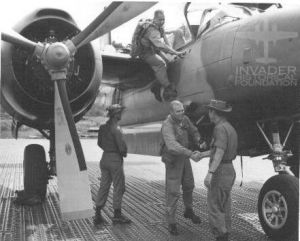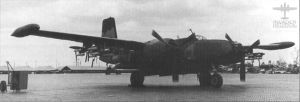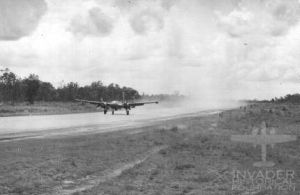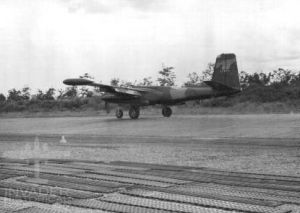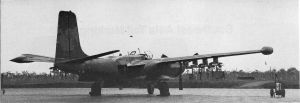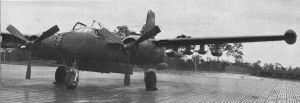609th Special Operations Squadron
| 609th Air Commando Squadron | |||
|---|---|---|---|
| Air Force: | |||
| Division: | |||
| Wing: 56th Air Commando Wing | |||
| Active: 22 Aug 1967- 1 Dec 1969 | |||
| Theater Southeast Asia | |||
| Motto: | |||
| Aircraft: Douglas B-26K | |||
| Commanders: LtCol Howard L. Farmer 1 Aug 67-1 Jan 68 | |||
The 609th Special Operations Squadron was organized as the 609th Air Commando Squadron at Nakhon Phanom RTAFB, Thailand on 15 September 1967. It was assigned to the 56th Air Commando Wing. The squadron flew the Douglas A-26 Invader, a twin engine attack bomber of WWII vintage. The first aircraft for the unit were transferred from the 603rd Air Commando Squadron - Detachment 1, which was attached to the 606th Air Commando Squadron. The 606th itself never flew B-26Ks, they flew Trojans. The primary mission of the 609th was night interdiction of truck traffic along the Ho Chi Minh Trail. Its call sign for these missions was "Nimrod", inherited from the 606th and other squadrons that had flown that mission, and "The Nimrods" soon became the squadron's nickname. The squadron's A-26 aircraft carried tail letters "TA".
On 1 August 1968, all Air Commando Wings were redesignated as Special Operations Units, and the 56th Air Commando Wing became the 56th Special Operations Wing, with the 609th Air Commando Squadron becoming the 609th Special Operations Squadron.
The night interdiction tasks of the 609th were gradually taken over by squadrons flying Lockheed AC-130 gunships, and the A-26 aircraft were phased out of active service by November 1969. By the time the last four surviving A-26s were withdrawn at the unit stand down, the squadron had flown 7,159 combat sorties for a total of 19,762.7 combat flying hours. During this period, the Nimrods were credited with destroying 4,268 trucks and damaging 696 more. The Nimrods also destroyed 201 enemy gun emplacements and silenced an additional 696. The extremely high truck kill record, averaged slightly better than 1 truck destroyed or damaged for each one and one-half sortie flown. This was significantly higher than any other weapon system currently in use in the Southeast Asian Theater.
The 609th was inactivated on 1 December 1969. The squadron's losses had been heavy, and it was awarded the Presidential Unit Citation for gallantry.
The remains of two squadron pilots, Maj. James E. Sizemore and Maj. Howard V. Andre, shot down over Laos in 1969, were recovered in 2013 and buried at Arlington National Cemetery.
Operational History
Oct-Nov 1969
The following excerpt comes from the History of the 56th Special Operations Wing - Oct-Dec 1969 Vol 1, Pages 156-164 (Reel M0782 pages 174-183):
The 609th Squadron was first commanded by LtCol Howard L. Farmer, who was followed in that capacity by LtCols Allen F. Learmonth, Robert E. Brumm, John J. Shippey, Altee R. Ellis, Robert L. Schultz, Robert W. Stout, and Jackie R. Douglas.
The Primary mission of the 609th and their association with the 56th Special Operations Wing was to conduct combat operations as directed. They were also fragged to fly reconnaissance, flare support, and FAC missions to disrupt and harass enemy lines of communication and supply by attacking or directing attacks on pre-selected targets and targets of opportunity in BARREL ROLL, STEEL TIGER NORTH, and STEEL TIGER SOUTH areas of Laos.
During October of this quarter, activity increased for the Nimrods with a 700 percent increase in air strikes against trucks. Most of this truck activity was in the STEEL TIGER portion of Laos. Consequently, an ever increasing number of the squadrons sorties were flown in this area.
The Nimrods continued to lend support to the friendly ground forces in Laos, with 18 percent of their missions being used for this purpose. The use of Nimrods for this close air support posed somewhat of a problem as a squadron policy dictated that new crews (those with less than 30 missions) could not be used for close air support. This policy was instituted to allow the new crews to become accustomed to striking in combat situations, and thereby lessen the possibility of a short round.
There were no new problems encountered during the month; however, some recurrent problems reappeared. On 23 October, Nimrod 22 and 23 were sent by MOONBEAM to 130/62/93 against troops in contact. Knowing that this area was in BARREL ROLL WEST and hence not validated for napalm, the Nimrods advised MOONBEAM that 22 was carrying 6 napalm and only 2 hard bombs. MOONBEAM told them to go anyway, drop the two hards and then come back out over the trail to get rid of his napalm.
A similar incident occurred on 25 October. As Nimrod 32 and 33 climbed out en route to BARREL ROLL, they were called by a Candlestick and advised that another Candle had spotted 15 trucks in STEEL TIGER NORTH, but unable to get any ordnance.
The Nimrods contacted ALLEYCAT with their request for diversion to the Candle, but their request was turned down as they were "really needed" in the BARREL. Once in the BARREL they were first held for 20 minutes, and then sent to a BLINDBAT FAC who didn't have any active targets, but would put them in on their secondary target.
Enroute to BLINDBAT the Nimrods hear that LULU, one of the FACS, was in trouble and needed help. Again, the Nimrods volunteered, but again their request was denied as "Napalm was not allowed on troops in contact." Since this was contrary to the briefed Rules of Engagement the Nimrods questioned this statement, but to no avail.
Finally, just as the Nimrods were about to strike their fragged secondary target, ALLEYCAT called to say that they couldn't strike that target either as it wasn't validated for napalm. By this time the Nimrods were low on fuel so BLINDBAT found a "truck" on the road so that they could get rid of their ordnance and go home.
One of the most frustrating problems that the Nimrods encountered was to be working a target, especially trucks, and then be pulled off so that some flights of jets that were bingo fuel could come in and strike. This proved to be the case on 25 October for Nimrods 22 and 23. After they had trapped 19 trucks by interdicting the road on both ends of the convoy, they were pulled off the target 3 times for fast mover flights.
Another problem was caused by high traffic density in the strike areas. On 18 October Nimrods 34 and 35 were in the BARREL ROLL. ETHAN, the airborne radar control for that area had the Nimrods and another flight at the same location and same altitude passing head on. ETHAN gave no warning to either flight.
On 19 October Nimrod 37 almost shot down a fast mover with his rockets, as he rolled in on a target. The F-4 flew through the strike area twice.
The top BDA (Battle Damage Assessment) for the month was recorded by Nimrod 30 piloted by Maj. Charles Bate and Nimrod 31 piloted by Maj Keller. On 21 Oct they destroyed 15 Military structures and damaged 20. Maj Koyn, in Nimrod 32, destroyed 4 trucks on 30 October.
During October, due to an extreme shortage of M-1A4 Fragmentation bombs, or the lack of a suitable substitute, Nimrod aircraft were loaded with one-half full, or even empty bomb bays for the last 10 days of the month. The long-awaited M-35-36 incendiary weapons arrived during this period; unfortunately they were not certified for use on the A-26 aircraft.
In November, the wing received instructions from CINCPACAF directing them that all 14 A-26 aircraft would be maintained in flyable storage at Clark AFB, PI to await further disposition instructions. CINCPACAF also informed the wing that a spares kit for all 14 aircraft would also be required.
The truck activity increased sharply in STEEL TIGER during the first 9 days of November. The squadron struck at only 3 less trucks than they did during the entire month of October.
The squadron truck kill was identical with the October results, with 29 trucks destroyed and 5 trucks damaged. The 609th ceased combat operations on 10 November.
Many of the same problems of the previous month remained with the squadron at the end. A problem has always existed with dud Ordnance, but this problem reached a new high on 5 November when Nimrod 24 dropped 8 dud napalms. This high dud rate was highly frustrating to the crews.
On 3 November, Nimrods 30, 31, 32, and 33 were all launched to missions in STEEL TIGER. Once in the area, each flight of Nimrods was held for more than 2 hours before being given a target to strike, hurried through the strike, and then hustled out of the way so that there wouldn't be any A-26s in the way of the fast movers and AC-130 gunships. This appeared to be a great waste of ordnance, especially considering the statistically superior strike efficiency of the A-26.
On 4 November, Nimrod 20, piloted by Maj Bates was involved in a highly dangerous situation with a Night Owl F-4. During their strike against trucks, the Nimrods were shot at by an enemy anti-aircraft gun position. The Night Owl reacted to the gun without first determining if there were other aircraft already in the area. Consequently, the Night Owl started dropping flares directly through the Nimrod strike pattern.
Major Koyn, piloting Nimrod 20, had the best BDA results for the month. On 9 November , Maj Koyn destroyed 4 trucks and silenced 1 37mm gun position.
Ground fire directed at the squadron's aircraft increased markedly during the month of November. There was a 250 percent increase over the totals for the month of October, and the squadron only flew 9 days in November.
Upon deactivation of the 609th Special Operations Squadron, Lt. Gen . Francis C. Gideon, Thirteenth Air Force commander, sent the following message to Col. Samuel E. Crosby, Jr, 56th Special Operations Wing commander; and Lt. Col. Jackie R. Douglas, 609th Commander:
The inactivation of the 609th Special Operations Squadron ends another significant chapter in the history of the 56th Special Operations Wing. Major contributions to our combat efforts in Southeast Asia were made through the dedication of every man in this fine organization. All of them - aircrew members and support personnel alike - share in the successful accomplishment of their important and difficult missions. Daily their professionalism and devotion to duty raised to ever higher levels those standards of excellence which have gained deserved recognition for this unit. Please convey my personal appreciation to the officers and men of the 609th Special Operations Squadron for the superior job they have done.
A similar message was sent by Brig. Gen. Wendell L. Bevan, Jr, Seventh Air Force Director of Combat Operations, who stated:
The day rapidly approaches when the 56th Special Operations Wing will lose one of its finest combat squadrons in SEA - the 609th SOS "Nimrods" - "A one of a kind" outfit - produced BDAs under conditions where our more sophisticated weapons systems were stymied. Their loss, through deactivation on 10 November 1969, signals the end of an era for the grand old A-26 and the crews who flew it. The 609th can justly be proud of its participation in what history could well term "The Most Crucial Campaign in SEA" - that of our STEEL TIGER interdiction program. They literally wrote the book on how to kill trucks at night and in the most hostile AAA environment we have encountered.
BDA statistics are of interest to everyone sitting in judgement of concepts, tactics, units, aircraft types, etc. The cumulative totals from May 1968 through Oct 1969 reflect 2,053 trucks destroyed, 394 trucks damaged, 28 guns destroyed, 3,521 troops KBA, 6,655 secondary fires, 7,145 secondary explosions from A-26 strikes. I consider these figures a true measure of the dedication and skill of the famed Nimrods.
Please convey to the 609th SOS my personal regrets over the deactivation of such a proud and professional organization. Their contributions to the goals and objectives of the USAF in SEA will be long remembered.
On 19 December, the Wing was informed by CINCPACAF that the requirement to hold the A-26 aircraft for Indonesia no longer existed. Therefore, all fourteen A-26 aircraft which were temporarily assigned to Clark AFB after being shuttled from NKP, would be returned to the CONUS and delivered to MASDC for reclamation.
The wing received another message from Langley AFB, VA, the same day stating that ferry tanks would be required for the return trip to the CONUS. Because of the limited communications/navigation capability of the A-26 aircraft and the number of aircraft being delivered, they requested PACAF to provide enroute support/escort aircraft, support kit and team to assist in the delivery of the aircraft.
The wing was in turn fragged for the job of ferrying the aircraft back to the states by providing 9 crews consisting of a pilot, navigator, and crew chief.
People
| Rank | Name | Date Left | Role | Comments |
|---|---|---|---|---|
| CPT | Robert E. Pietsch | May 1968 | Pilot | MIA 30 Apr 1968 |
| MAJ | Richard Mendonca | May 1968 | Pilot | |
| LTCOL | Howard L. Farmer | May 1968 | Pilot | C.O. 1 Aug 1967 - 1 Jan 1968 |
| MAJ | Robert W. Bakken | Jun 1968 | Pilot | |
| MAJ | Bennie L Heathman | Jun 1968 | Pilot | |
| MAJ | Richard P. Schramm | Jul 1968 | Pilot | |
| CPT | Michael J. Roth | Jul 1968 | Pilot | |
| MAJ | Edward M Robinson | Jul 1968 | Pilot | |
| CPT | Bruce R Wolfe | Aug 1968 | Pilot | |
| CPT | Seijun Tengan | Sep 1968 | Pilot | |
| MAJ | Kenneth E. Lafave | Oct 1968 | Pilot | |
| MAJ | John A. Parrish | Oct 1968 | Pilot | |
| LTCOL | John J. Shippey | Nov 1968 | Pilot | C.O. 1 Jul-1 Nov 1968 |
| LTCOL | Robert L. Brumm | Nov 1968 | Pilot | C.O. 1 Jan-1 Jul 1968 |
| LTCOL | Atlee R. Ellis | Nov 1968 | Pilot | C.O. 1 Nov-5 Nov 1968 |
| MAJ | Bobby J. Sears | Nov 1968 | Pilot | |
| MAJ | Bernard N Disteldorf | Nov 1968 | Pilot | |
| MAJ | Mark R Richards | Nov 1968 | Pilot | |
| MAJ | Robert F. Bennett | Dec 1968 | Pilot | |
| CPT | Jay L Norton | Dec 1968 | Pilot | |
| MAJ | Daniel F. Grob | Dec 1968 | Pilot | |
| LTCOL | Douglas W. Carmichael | Apr 1969 | Pilot | O.O. 1 Nov 1968-1 Apr 1969 |
| MAJ | Delbert W Litton | May 1969 | Pilot | |
| MAJ | Charles A Kenyon | Jun 1969 | Pilot | |
| MAJ | Lee D Griffin | Jun 1969 | Pilot | |
| LTCOL | Robert L. Schultz | Jul 1969 | Pilot | C.O. 5 Nov 1968-1 Jul 1969 |
| MAJ | Elmer E Peters | Jul 1969 | Pilot | |
| MAJ | Albert Shortt | Jul 1969 | Pilot | O.O. 1 Apr-1 Jul 1969 |
| MAJ | James G. Fitzgerald | Jul 1969 | Pilot | |
| MAJ | Charles C. Vogler | Sep 1969 | Pilot | |
| MAJ | Kenneth E Yancey | Sep 1969 | Pilot | |
| CPT | Roscoe R. Roberts III | May 1969 | Pilot | |
| MAJ | Milton J Warner | Oct 1969 | Pilot | |
| MAJ | Robert L. Dixon | Nov 1969 | Pilot | |
| MAJ | Charles T Bates | Nov 1969 | Pilot | |
| CPT | Anthony M. Hotsko | Nov 1969 | Pilot | |
| MAJ | Joe A. Jefferis | Dec 1969 | Pilot | |
| CPT | Paul M. Marschalk | Dec 1969 | Pilot | |
| CPT | James W. Widdis | Dec 1969 | Pilot | MIA 21 Mar 1969 |
| CPT | Neal E Monette | Dec 1969 | Pilot | KIA 12 Mar 1969 |
| LTCOL | Floyd A Peede | Mar 1969 | Pilot | |
| MAJ | James E Sizemore | Jan 1970 | Pilot | KIA 4 Jul 1969 |
| LTCOL | Robert W Stout | Mar 1970 | Pilot | C.O. 1 Jul 1969 |
| MAJ | William H Lorimar | Mar 1970 | Pilot | |
| MAJ | Daniel W Koyn | Mar 1970 | Pilot | |
| CPT | Eddie L. Parris | Mar 1970 | Pilot | |
| CPT | Peter F Peterson | Mar 1970 | Pilot | |
| MAJ | Henry J. Mauldin | Mar 1970 | Pilot | |
| CPT | Michael King | Apr 1970 | Pilot | |
| MAJ | Robert C Mason | May 1970 | Pilot | |
| MAJ | Richard G Keller | May 1970 | Pilot | |
| MAJ | Francis E Riley | Jun 1970 | Pilot | |
| CPT | Thomas E. Owens | Jun 1968 | Navigator | |
| CPT | George B. Hertlein III | Jun 1968 | Navigator | KIA 24 Apr 1968 |
| CPT | Louis F. Guillerman | Jun 1968 | Navigator | MIA 30 Apr 1968 |
| MAJ | Douglas W. Hawkins | Jul 1968 | Navigator | |
| MAJ | Bryant A. Murray | Jul 1968 | Navigator | |
| LTCOL | Francis L. McMullen | Jul 1968 | Navigator | |
| MAJ | Donald W. Maxwell | Jul 1968 | Navigator | |
| CPT | Lawrence J. Elliot | Aug 1968 | Navigator | |
| MAJ | Robert C. Zimmerman | Sep 1968 | Navigator | |
| CPT | Frank W. Nelson | Sep 1968 | Navigator | |
| MAJ | Robert W. Squires | Sep 1968 | Navigator | |
| CPT | Roger D. Graham | Oct 1968 | Navigator | |
| CPT | Leroy D. Zarucchi | Oct 1968 | Navigator | |
| CPT | Richard L. Willems | Oct 1968 | Navigator | |
| CPT | Ernest J. Wiedenhoff | Nov 1968 | Navigator | |
| CPT | Thomas E. Bronson | Dec 1968 | Navigator | |
| CPT | William A. Cohen | Dec 1968 | Navigator | |
| MAJ | Peter R. Bowman | Jan 1969 | Navigator | |
| MAJ | Walter M. Langford | Mar 1969 | Navigator | |
| MAJ | Loran W. Gierhart | Mar 1969 | Navigator | |
| CPT | Michael D. Henry | Apr 1969 | Navigator | |
| CPT | Charles P. Laws | Apr 1969 | Navigator | |
| CPT | Jerry L. Meek | Apr 1969 | Navigator | |
| CPT | Lawrence J. Counts | Jun 1969 | Navigator | |
| MAJ | James E. Richeal | Sep 1969 | Navigator | |
| MAJ | Marion R. Watson | Sep 1969 | Navigator | |
| CPT | Norman D. Wolf | Sep 1969 | Navigator | |
| LT | Ferde P. Arbeit | Sep 1969 | Navigator | |
| LT | Arthur R. Fisher | Sep 1969 | Navigator | |
| LT | John R. Terry | Sep 1969 | Navigator | |
| MAJ | Howard V. Andre Jr | Nov 1969 | Navigator | KIA 4 Jul 1969 |
| CPT | Larry L. Ullrey | Nov 1969 | Navigator | |
| MAJ | John V. Callahan | Nov 1969 | Navigator | KIA 12 Mar 1969 |
| CPT | Patrick J. Smith | Nov 1969 | Navigator | |
| MAJ | Earl E. Milam | Nov 1969 | Navigator | |
| MAJ | Michael W. Michelsen | Dec 1969 | Navigator | |
| MAJ | Sidney I. Richard | Dec 1969 | Navigator | |
| CPT | Leon J. Poteet | Dec 1969 | Navigator | |
| CPT | Robert C. Davis | Dec 1969 | Navigator | MIA 21 Mar 1969 |
| MAJ | Davied R. Dalton | Apr 1969 | Navigator | |
| LT | Richard R. Cutler | Apr 1969 | Navigator | |
| CPT | Nolan W. Schmidt | Mar 1970 | Navigator | |
| MAJ | Adolph W. Foeh | Mar 1970 | Navigator | |
| LT | David P. Talbert | Mar 1970 | Navigator | |
| MAJ | Floyd J. Abrames | Mar 1970 | Navigator | |
| LTCOL | James R. Wilson | Apr 1970 | Navigator | |
| LT | Edward M. Hickly | Apr 1970 | Navigator | |
| LT | Thomas R. Bernhardt | May 1970 | Navigator | |
| LT | Paul S. Howe | May 1970 | Navigator | |
| CPT | Delbert A. Post | Jun 1970 | Navigator | |
| LT | August C. Janarone | Mar 1969 | Navigator | TDY From 603rd Special Operations Squadron 10 Jan to 10 Mar 1969 |
Planes
Note that the Date Assigned field in this table denotes the date that the plane was first assigned to NKP, not necessarily when the plane was assigned to the 609th. The 609th was not officially formed until Aug 1967, so any assignments prior to that date would be either Project Big Eagle (603rd Air Commando Squadron, Detachment 1), or the 606th Air Commando Squadron.
| Serial Number | Date Assigned | Date Left | Comments |
|---|---|---|---|
| 64-17641 | 30 Sep 1967 | 29 Dec 1967 | Shot down by AA. |
| 64-17642 | 21 Dec 1966 | 27 Aug 1967 | Shot down. |
| 64-17643 | 11 Jun 1966 | 25 Jul 1966 | Destroyed in crash. Was attached to the 606 ACS, 56 AWC, but on paper was part of the 603 ACS, 1 ACW. |
| 64-17644 | 1 Nov 1967 | 12 Nov 1969 | Sent to Clark AFB for storage. |
| 64-17645 | 31 May 1967 | 10 Nov 1969 | Scuttled in Vietnam in 1975. |
| 64-17646 | 6 Aug 1967 | 8 Jul 1969 | Crashed during combat. |
| 64-17648 | 4 oct 1967 | 30 Apr 1968 | Shot down by AA. |
| 64-17649 | 13 May 1967 | 10 Nov 1969 | Sent to Clark AFB for storage. |
| 64-17650 | 11 Jun 1966 | 28 Jun 1966 | Shot down by enemy ground forces. |
| 64-17651 | 11 Oct 1967 | 10 Nov 1969 | Sent to Clark AFB for storage. |
| 64-17652 | 27 Sep 1968 | 10 Nov 1969 | Sent to Clark AFB for storage. |
| 64-17653 | 14 Jul 1968 | 13 Nov 1969 | Sent to Clark AFB for Storage. |
| 64-17654 | 31 Oct 1967 | 10 Nov 1969 | Sent to Clark AFB for Storage. |
| 64-17660 | 21 Dec 1966 | 12 Nov 1969 | Went back to SMAAR Aug 1967 and Apr 1968 for repairs. Sent to Davis-Monthan AFB for storage. |
| 64-17661 | 21 Oct 1967 | 10 Nov 1969 | Sent to Clark AFB for storage. |
| 64-17662 | 16 Jun 1967 | 22 Aug 1967 | Missing in Action 22 Aug 1967. |
| 64-17664 | 21 Dec 1966 | 9 Nov 1967 | Sent to Kadena, JP, then to OnMark. |
| 64-17665 | 11 Jun 1966 | 10 Nov 1969 | Sent to Clark AFB for storage. |
| 64-17666 | 1 Nov 1968 | 10 Nov 1969 | Sent to Clark AFB for storage. |
| 64-17667 | 11 Jun 1967 | 23 Mar 1969 | Sent to SMAAR Jun 1967. Shot down 23 Mar 1969. |
| 64-17668 | 11 Jun 1966 | 22 Feb 1967 | Shot down by AA 22 Feb 1967. |
| 64-17669 | 11 Jun 1966 | 22 Feb 1967 | Destroyed when 64-17668 exploded in mid-air. |
| 64-17670 | 1 Nov 1968 | 10 Nov 1969 | Sent to Clark AFB for storage. |
| 64-17671 | 11 Jun 1966 | 6 Jul 1967 | Sent back to SMAAR, then 1st ACW. |
| 64-17671 | 21 Nov 1967 | 10 Nov 1969 | Returned to Vietnam. Sent to Clark AFB for storage. |
| 64-17672 | 11 Jun 1966 | 14 Dec 1966 | Shot down 14 Dec 1966 |
| 64-17673 | 21 Dec 1966 | 11 Mar 1969 | Sent to SMAAR Jul 1967. Destroyed in Crash landing 11 Mar 1969. |
| 64-17675 | 1 Dec 1966 | 7 Jun 1968 | Went to OnMark Oct 1967. Sent to 1st ACW. |
| 64-17675 | 1 Nov 1968 | 13 Nov 1969 | Sent to Clark AFB to storage. |
| 64-17676 | 11 Jun 1966 | 3 Aug 1967 | Sent to SMAAR, then 1st ACW. |
| 64-17677 | 3 Aug 1967 | 10 Nov 1969 | Sent to Clark AFB for storage. |
| 64-17678 | 8 Aug 1967 | 13 Nov 1967 | Sent to 1st ACW. |
